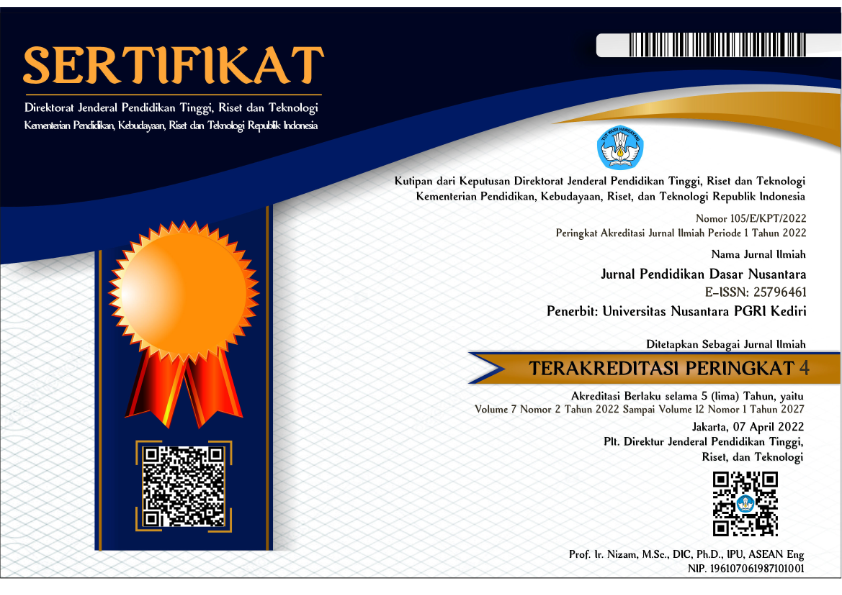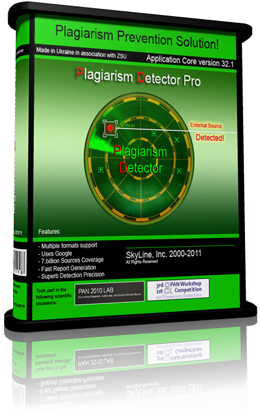Dampak Pembelajaran Daring Terhadap Kemampuan Anak Usia Sekolah Dasar
DOI:
https://doi.org/10.29407/jpdn.v7i1.15890Keywords:
online learning, online learning impact, children’s ability improvement, children’s ability declineAbstract
This research aimed at describing the impact of online learning during COVID-19 pandemic toward primary-aged children’s ability. The research was conducted at State Elementary School of Rejodadi. The descriptive survey of quantitative method was employed to carry out this research. The data collecting technique was done by filling out an online questionnaire through Google Form. The collected data reached were 124 of 178 parents of the students from the first to sixth grade. Data analyses used were data collection, reduction, data display, and conclusion. The data analysis technique used was modus and percentage. The research reveals that online learning during COVID-19 pandemic gives impacts on children’s ability improvement and decline such as thinking, language, mathematical, technological, communication, physical, and prayer ability. The greatest improvement of children ability is on technological ability (36%) and thinking ability (17%), while the greatest decline of children ability is on thinking ability (33%) and physical ability (19%).
Downloads
References
Ababneh, S., & Lababneh, S. (2013). The Effect of Using the Internet on EFL Elementary School Students’ Writing. Journal of Education and Practice, 4(2), 103–109. https://iiste.org/Journals/index.php/JEP/article/view/4074/4109
Abdulrahman, N. C., & Ayyash, E. A. S. A.-. (2019). Linguistic competence, Communicative Competence and Interactional Competence. Journal of Advances in Linguistics, 10(November), 1600–1616. https://doi.org/10.24297/jal.v10i0.8530
Aflakseir, A., & Coleman, P. G. (2011). Initial development of the Iranian religious coping scale. Journal of Muslim Mental Health, 6(1), 44–61. https://doi.org/10.3998/jmmh.10381607.0006.104
Ally, M., & Prieto-Blázquez, J. (2014). ¿Cuál es el futuro del aprendizaje móvil en la educación? RUSC Universities and Knowledge Society Journal, 11(1), 142–151. https://doi.org/10.7238/rusc.v11i1.2033
Australian Council of State School Organisations. (2008). Family - School Partnerships Framework. Review, 43. http://www.familyschool.org.au/pdf/framework.pdf
Baruah, K. (2015). Learners’ consistency in mathematics performance-an investigation through statistical procedure. Asian Journal of Science and Technology, 6(7), 1608-1612.
Bhamani, S., Makhdoom, A. Z., Bharuchi, V., Ali, N., Kaleem, S., & Ahmed, D. (2020). Home Learning in Times of COVID: Experiences of Parents. Journal of Education and Educational Development, 7(1), 9. https://doi.org/10.22555/joeed.v7i1.3260
Bransford, J.D., Brown, A.L., & Cocking, R. (2000). How Experts Differ from Novices. In How People Learn: Brain, Mind, Experience, and School. https://doi.org/10.17226/9853
Bujuri, D.A. (2018). Analisis perkembangan kognitif anak usia dasar. Literasi, 9(1), 37-50.
Daniel, S. J. (2020). Education and the COVID-19 pandemic. Prospects, 0123456789. https://doi.org/10.1007/s11125-020-09464-3
Emmy, Rosalia. (2008). Menjadi Ortu Cerdas Tips Mendampingi Anak Belajar. Yogyakarta: Kanisius.
Fotiadou, A., Angelaki, C., & Mavroidis, I. (2018). Learner Autonomy as a Factor of the Learning Process in Distance Education. European Journal of Open, Distance and E-Learning, 20(1), 96–111. https://doi.org/10.1515/eurodl-2017-0006
Halupa, C.P. (2016). Risks: The impact of online learning and technology on student physical, mental, emotional, and social health. A paper presented at International Technology, Education, and Development Conference, November 2016 . DOI: 10.21125/iceri.2016.0044.
Haryadi, T., & Aripin. (2015). Melatih kecerdasan kognitif, afektif, dan psikomotor anak sekolah dasar melalui perancangan game simulasi “Warungku”. Andharupa Jurnal Komunikasi Visual dan Multimedia, 1(2), 39-50.
Hoic-Bozic, N., Mornar, V., & Boticki, I. (2009). A blended learning approach to course design and implementation. IEEE Transactions on Education, 52(1), 19–30. https://doi.org/10.1109/TE.2007.914945
Hollingworth, S., Mansaray, A., Allen, K., & Rose, A. (2011). Parents’ perspectives on technology and children’s learning in the home: Social class and the role of the habitus. Journal of Computer Assisted Learning, 27(4), 347–360. https://doi.org/10.1111/j.1365-2729.2011.00431.x
Hoskins, Sherria L, & van Hooff, Johanna C. (2005). Motivation and ability: which students use online learning and what influence does it have on their achievement? British Journal of Educational Technology, 31(2), 177–192.
Huang, R. (2018). Mainstreaming digital skills to embrace the digital era. Paper presented at the UNESCO Mobile Learning Week, Paris.
Hwang, G.-J. (2014). Definition, framework and research issues of smart learning environments - a context-aware ubiquitous learning perspective. Smart Learning Environments, 1(1), 1–14. https://doi.org/10.1186/s40561-014-0004-5
Kang, M., & Im, T. (2013). Factors of learner-instructor interaction which predict perceived learning outcomes in online learning environment. Journal of Computer Assisted Learning, 29(3), 292–301. https://doi.org/10.1111/jcal.12005
Lynch, K. (1999). The social impact of on-line learning. ASCILITE99 Conference Procedings, Clayton: 1999.
Loucks, H. (1992). Increasing parent/family involvement: Ten ideas that work. NASSP Bulletin, 76(543), 19-23.
Magwa, S., & Mugari, S. (2017). Factors Affecting Parental Involvement in the Schooling of Children. International Journal of Research and Reflection, 5(1), 74–81.
McBrien, J. L., Jones, P., & Cheng, R. (2009). Virtual spaces: Employing a synchronous online classroom to facilitate student engagement in online learning. International Review of Research in Open and Distance Learning, 10(3), 1–17. https://doi.org/10.19173/irrodl.v10i3.605
Metiri Group. (2003). Engage 21st Century Skills: Literacy in the Digital Age. NCREL and Metiri Group: Illinois and California.
Mike, D. G., & Mike, D. G. (2016). Internet in the schools: A literacy perspective. Journal of Adolescent and Adult Literacy, 40(1), 1-13.
Miller, T. (2018). Developing numeracy skills using interactive technology in a play-based learning environment. International Journal of STEM Education, 5(1). https://doi.org/10.1186/s40594-018-0135-2
Mohammadi, N., Ghorbani, V., & Hamidi, F. (2011). Effects of e-learning on language learning. Procedia Computer Science, 3, 464–468. https://doi.org/10.1016/j.procs.2010.12.078
Nguyen, V. A. (2017). The Impact of Online Learning Activities on Student Learning Outcome in Blended Learning Course. Journal of Information and Knowledge Management, 16(4). https://doi.org/10.1142/S021964921750040X
Nurgiyantoro, Burhan., Gunawan., & Marzuki. (2014). Statistik Terapan untuk Penelitian Ilmu Sosial. Yogyakarta: Gajah Mada University Press.
Owusu-Fordjour, C., Koomson, C. K., & & Hanson, D. (2020). The impact of COVID-19 on learning-the perspective of the Ghanaian student. European Journal of Education Studies, 7(3), 88–101. https://doi.org/10.5281/zenodo.3753586
Pajarianto, D. (2020). Study from Home in the Middle of the COVID-19 Pandemic: Analysis of Religiosity, Teacher, and Parents Support Against Academic Stress. Talent Development & Excellence, 12(2), 1791–1807.
Rajkumar, R., & Hema, G. (2016). E-learning strategies as a way to improve Mathematics education. In K. Viyarani & K.S. Ramakrishnan (Eds). Digital Pedagogies: The Road Ahead. Paper presented at the National Seminar on Virtual Learning Platforms in Higher Education: Developments, Directions, Issues and Challenges organized Department of Education, Bharathiar University, Coimbatore (pp. 122-126). Tirchy: The Printing House.
Reeves, J. L., Gunter, G. A., & Lacey, C. (2017). Mobile learning in pre-kindergarten: Using student feedback to inform practice. Educational Technology and Society, 20(1), 37–44.
Sabau, I., & Sabau, M. (2008). Online Learning: Visual Thinking and Literacy. Bulletin of the Transilvania University of Brasov. Economic Sciences. Series V, 1(50), 101–108.https://search.proquest.com/openview/a6fb808d1a2edf03e9be5ab057361d33/1?pq origsite=gscholar&cbl=105975
Sari, I.D.P., & Rahmah, T.H. ((2019). Virtual Discussion for EFL Students Establishing Three Domains: Cognitive, Affective, and Psychomotor. International Journal for Educational and Vocational Studies, 1 (3), 249-253.
Siegler, R. S., & Mu, Y. (2008). Chinese children excel on novel mathematics problems even before elementary school. Psychological Science, 19(8), 759–763. https://doi.org/10.1111/j.1467-9280.2008.02153.x
Soliman, N. A. (2014). Using E-Learning to Develop EFL Students’ Language Skills and Activate Their Independent Learning. Creative Education, 05(10), 752–757. https://doi.org/10.4236/ce.2014.510088
Tarango, J, & Machin-Mastromatteo, J.D. (2017). The Role of Information Professionals in the Knowledge Economy: Skills, Profile and a Model for Supporting Scientific Production and Communication. Oxford: Chandos Publishing.
UNESCO. (2020). COVID-19 Educational disruption and response. Retrieved from https://en.unesco.org/themes/education-emergencies/coronavirus-school-closures
Wang, G., Zhang, Y., Zhao, J., Zhang, J., & Jiang, F. (2020). Mitigate the effects of home confinement on children during the COVID-19 outbreak. The Lancet, 395(10228), 945–947. https://doi.org/10.1016/S0140-6736(20)30547-X
Presser, A. L., Vahey, P., & Domininguez, X. (2015). Improving mathematics learning by integrating curricular activities with innovative developmentally appropriate digital apps: findings from the next generation preschool math evaluation. In SREE Spring 2015 Conference.
Downloads
Published
Issue
Section
License
Authors who publish with this journal agree to the following terms:
- Copyright on any article is retained by the author(s).
- The author grants the journal, the right of first publication with the work simultaneously licensed under a Creative Commons Attribution License that allows others to share the work with an acknowledgment of the work’s authorship and initial publication in this journal.
- Authors are able to enter into separate, additional contractual arrangements for the non-exclusive distribution of the journal’s published version of the work (e.g., post it to an institutional repository or publish it in a book), with an acknowledgment of its initial publication in this journal.
- Authors are permitted and encouraged to post their work online (e.g., in institutional repositories or on their website) prior to and during the submission process, as it can lead to productive exchanges, as well as earlier and greater citation of published work.
- The article and any associated published material is distributed under the Creative Commons Attribution-ShareAlike 4.0 International License

































